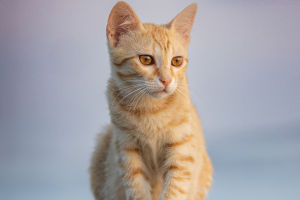Whether it's during a cuddle or while they're dozing on the windowsill, our cats often let out that soft, soothing "purr." But have you ever paused and asked yourself—why do they do that?
Is it always because they're happy? Today, let's explore the true reason behind that calming sound and what it really means for both cats and us.
What Exactly Is a Cat's Purr?
We hear it, we feel it, but what's happening inside our cat's body when it purrs? Scientists say that purring is created by the rapid movement of the muscles within a cat's larynx (voice box), combined with movement in the diaphragm. These vibrations occur at a frequency between 25 and 150 Hertz.
Surprisingly, cats can purr while inhaling and exhaling, which is what gives it that continuous, rhythmic sound we all recognize.
Not Just a Sign of Happiness
We often assume our cat is purring because they're content—and yes, many times that's true. But it's not the only reason. Cats also purr when they are stressed, frightened, injured, or even at the vet. Sounds strange, right?
Dr. Elizabeth von Muggenthaler, a specialist in bioacoustics, explains that purring may be a survival mechanism. Cats may use it to calm themselves and even signal to others that they are not a threat. It's like their own version of self-soothing.
The Healing Power of Purring
Here's where things get even more fascinating: studies suggest that purring might have actual healing effects. According to research from the Journal of the Acoustical Society of America, the frequencies produced by purring are known to promote tissue regeneration and reduce pain and inflammation.
In fact, some animal behaviorists believe that cats purr to heal themselves after injury or strain—almost like an internal therapy. This might also explain why cats recover quickly from falls or fractures.
Purring for Communication
We've all experienced it: our cat climbs into our lap, looks into our eyes, and begins to purr softly. It's their way of communicating. Cats use purring to build bonds—with other cats, and with us.
Kittens begin purring just a few days after birth. It helps them connect with their mother and lets her know they're okay. That behavior carries on into adulthood. When our cat purrs around us, they're likely saying, "I feel safe with you."
Can Cats Purr to Help Humans?
Yes—indirectly, they can! Several studies suggest that the sound and vibration of a cat's purr can have a calming effect on humans. Lowering stress levels, reducing anxiety, and even helping with sleep are just some of the possible benefits.
Some therapists and researchers have even explored the role of purring in emotional support. Being around a purring cat might lower blood pressure and promote relaxation—something many cat lovers already feel firsthand. Dr. Lisa Koche, a triple board-certified physician and longevity expert, said, "The sound and vibration of a purring cat can have a calming effect on the nervous system. This can lower stress levels, reduce blood pressure, and create a sense of tranquility."
When to Pay Attention to Purring
While purring is often a positive sound, it's important to pay attention to context. If your cat is purring and showing signs of pain (like limping, hiding, or loss of appetite), it might be using purring as a way to comfort itself.
In those moments, we should gently observe and, if needed, consult a vet. Understanding their behavior helps us care for them more sensitively.
Let's Share Some Purring Moments!
Have you ever had a moment where your cat's purr calmed you down or made you feel connected? Or perhaps you've noticed your cat purring even when it's not being petted? Share your story with us—we'd love to hear how purring plays a role in your daily life.
The next time we feel that soft rumble on our lap, we can appreciate it not just as a sound of love, but as a built-in therapy tool that both heals and connects. Our cats aren't just showing affection—they're also caring for themselves, and maybe for us too.
Want to know more about other mysterious cat sounds or behaviors? Let us know what you'd like us to explore next!


